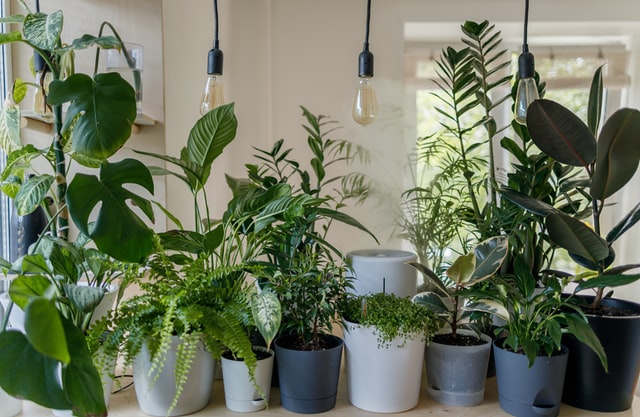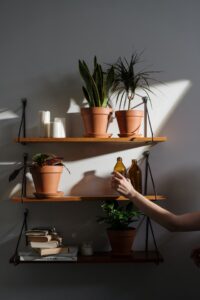The popularity of houseplants is on the rise, especially among those who are interested in interior design. It’s impossible to have too much greenery indoors, but how can you know which plants will thrive? Who says that filling your home with a ton of plants is the best option for those who don’t like to maintain them? Is it wrong to have plants in our bedroom? We have written a lot about indoor plants here. 
Best Indoor Plants
Plants that thrive in low light, as well as humidity, will flourish indoors. They will also be less prone to dealing with bugs. And they don’t usually grow too quickly.
The following are some more examples of the best indoor plants:
- Aglaonema – This plant is lovely, tolerates low light, and grows slowly.
- Aspidistra – It doesn’t require a lot of water and can thrive in poor light. If you want to go on vacation without worrying about your plant, aspidistra is the plant for you.
- Succulents
- Dracaenas\philodendrons
Some indoor plant ideas are more valuable for small space gardeners. Being a horticulture enthusiast and living in a small apartment was formerly mutually exclusive. The often dark, damp, or overly dry conditions are not ideal for indoor plants. And plants are trying to turn their living room into a makeshift greenhouse. When we consider how long do indoor plants live, on average indoor plants last 2-5 years. After that time, plants stop thriving, and that’s best to invest in another plant.
Which indoor plants require low light?
When it comes to the indoor plants low light, Indoor plants that require less light may be an excellent option for areas with lower lighting. Low-light plants include the following:
- Philodendron – A popular indoor plant that attracts few pests. It’s a hardy plant that may thrive in a variety of conditions.
- Pothos, often known as Devil’s Ivy, is a plant with brightly colored leaves. This plant can grow in a different environment, including low light and bright, indirect light.
- Dracaena– Another popular indoor plant with long green leaves is the Dracaena. If the foliage on this indoor plant becomes too long, it should be pruned.
- Peace Lily- This plant doesn’t like overwatered soil but grows best in wet. Move your peace lily plant to a darker environment if you want flowers to appear on it.
Advantages and Disadvantages of Indoor plants
When we answer what are indoor plants good for, we can say about the advantages of indoor plants. They are;
- Boosting your mood
- Fatigue reduction
- Stress and anxiety reduction
- Increasing office productivity and attention
- Increasing pain tolerance and healing
- Improving air quality to reduce the prevalence of headaches
According to some scientists, choosing the correct air purifying plants for your home can help detoxify the air in your living spaces. That means indoor plants will not only look nice but will also work a little harder to clean the air you breathe in.
Here are some of the best indoor plants for air purification.
- Barberton Daisy
- Snake Plant
- Chrysanthemum
- Spider Plant
- Aloe Vera
- Broad Lady Palm
- Weeping Fig
- English Ivy
On the other way of round, there have some disadvantages to indoor plants. When you don’t have the expertise to handle and maintain a place to adapt plants, indoor gardening or cultivating indoor plants might be complicated. Some of the reasons why are indoor plants bad are outlined in the following.
- Indoor Plant Care Requirements
- Indoor plants are usually more expensive.
- The majority of plants can survive in high humidity.
- Mould and bacteria thrive in the presence of plants.
- Indoor plants tend to outgrow their containers.
Why should you not put plants in your bedrooms?
While many plants emit carbon dioxide rather than oxygen during the night, a few plants in the bedroom will not emit enough carbon dioxide to be dangerous. In addition, not all plants emit CO2 at night. Even when they are not in the act of photosynthesis, certain plants release oxygen. Furthermore, certain plants filter toxic formaldehyde, benzene, and allergens from the air, thereby enhancing indoor air quality. Some plants also release relaxing and tranquilizing essential oils that aid in falling asleep faster and sleeping more soundly, making them ideal bedroom houseplants.

Conclusion
Indoor plants not only improve the overall beauty of a place, but they’ve also been proved to improve emotions, increase creativity, reduce stress, and eliminate air pollutants, resulting in a healthier and happier you. Indoor plants may make us feel better as well as look wonderful. Indoor plants are a terrific option for those who don’t have enough yard space for an outdoor garden or live in areas where the winters are bitterly cold. Sometimes indoor plants die due to some reasons. They are;
- Underwatering or overwatering
- Lighting Conditions (either not enough light or too much light)
- Ignorance
So, we must prune plants as required. If you don’t have a proper reason to prune your plants, do not. However, if your plant is becoming tatty and spindly, we propose pruning it.







Pingback: Member Of Mint Family – The Lavender Plants With A Sweet Floral Fragrance -
Pingback: A Tropical Wonder Plant Of Aloe Vera Plant: An Ancient Herb For Modern Dentistry -
Pingback: Snake Plant; Amazing Things You Should Know About Snake Plant -
Pingback: Amazing Thing You Need To Know About The Prayer Plant -
Pingback: Monstera Plant To Lighten Up Your Place -
Pingback: Spider Plant Is An Ideal Indoor As Well As An Outdoor Plant!
Pingback: Kalanchoe Plant - One Of The Must-have Tiny Flowering Plant!
Pingback: How To Grow Desert Rose? - Easiest Ways With Proven Tips
Pingback: How Do You Care For Pothos Plants? - Here Are Some Tips! - Mediosu
Pingback: How To Grow Tomatoes? - Find Growing Tomatoes For Beginners! - Mediosu
Pingback: Lavender Plants Brings You, Sweet Floral Fragrance, At Home!